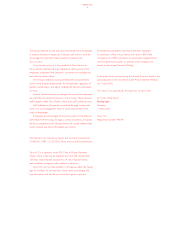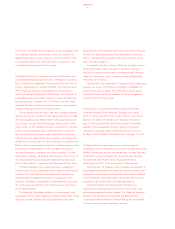Tesco 2000 Annual Report Download - page 11
Download and view the complete annual report
Please find page 11 of the 2000 Tesco annual report below. You can navigate through the pages in the report by either clicking on the pages listed below, or by using the keyword search tool below to find specific information within the annual report.
TESCO PLC
9
Statement of application of principles
of the Combined Code
The Group is committed to high standards of corporate governance.
This statement describes the manner in which the company has
applied the principles set out in Section 1 of the Combined Code
on Corporate Governance which have been incorporated in the
Listing Rules of the London Stock Exchange.
Directors
The Board of Tesco PLC comprises nine Executive Directors and
six independent Non-executive Directors. The Board is chaired by
Mr J A Gardiner, an independent Non-executive Director, who has
primary responsibility for running the Board. The Chief Executive,
Mr T P Leahy, has executive responsibilities for the operations,
results and strategic development of the Group. Clear divisions of
accountability and responsibility both exist and operate effectively
for these positions. In addition, Mr G F Pimlott is the senior Non-
executive Director. The Board structure ensures no one individual
or group dominates the decision-making process.
The full Board meets ten times a year and, in addition, annually
devotes two days to a conference with senior executives on longer
term planning giving consideration both to the opportunities and
risks of future strategy. The Board manages overall control of the
Group’s affairs by the schedule of matters reserved for its decision.
Insofar as corporate governance is concerned, these include the
approval of financial statements, major acquisitions and disposals,
authority levels for expenditure, treasury policies, risk management
policies and succession plans for senior executives. In order that the
Board is able to make considered decisions, a written protocol exists
and has been communicated to senior managers ensuring that
relevant information is presented to all Board members five days
before Board meetings. All Directors have access to the services of
the Company Secretary and may take independent professional
advice at the company’s expense in the furtherance of their duties.
The Board delegates day-to-day and business management
control to the Executive Committee which comprises the Executive
Directors. This meets formally every week and its decisions are
communicated throughout the Group on a regular basis. The
Executive Committee is responsible for implementing Group policy,
the monitoring and performance of the business and reporting to
the full Board thereon.
The Executive Committee conducts a risk assessment to the
achievement of the Group’s objectives at least annually which is then
discussed with the full Board and any appropriate actions taken.
Appointments to the Board for both Executive and Non-executive
Directors are the responsibility of the Nominations Committee
which is chaired by Mr J A Gardiner and whose members are set
out in the table on page 11.
As exemplified by the section on ‘Directors and their interests’
within the Directors’ Report on pages 7 and 8, the company’s
Articles of Association ensure that on a rotational basis Directors
resign every three years and, if so desire and being eligible, offer
themselves for re-election.
The Board has also established a Compliance Committee whose
purpose is to ensure that the Board discharges its obligations to
avoid civil and criminal liability. The Committee, comprising two
Executive Directors and three members of senior management,
normally meets four times a year.
Directors’ remuneration
The Board has a long-established Remuneration Committee,
composed entirely of Non-executive Directors, now chaired
by Mr C L Allen, with effect from 10 April 2000, in succession to
Baroness O’Cathain.The members are set out in the table on
page 11. The responsibilities of the Remuneration Committee
together with an explanation of how it applies the Directors’
remuneration principles of the Combined Code are set out in
the Report of the Directors on Remuneration on pages 12 to 16.
Relations with shareholders
The Board attaches a high importance to maintaining good
relationships with all shareholders and, primarily through the Investor
Relations department, ensures that shareholders are kept informed
of significant company developments. During the year, Directors
have met with more than 65 of our leading shareholders
representing over 45% of the issued shares of the company.
While the focus of dialogue is with institutional shareholders to
whom regular presentations are made on company direction, care is
exercised to ensure that any price-sensitive information is released
to all shareholders, institutional and private, at the same time as in
accordance with London Stock Exchange requirements.
The Board regards the Annual General Meeting as an
opportunity to communicate directly with private investors and
actively encourage participative dialogue. The Chairman, Executive
Directors and chairpersons of the Audit and Remuneration
Committees attend the Annual General Meeting and are available
to answer questions from shareholders present.
corporate governance
























